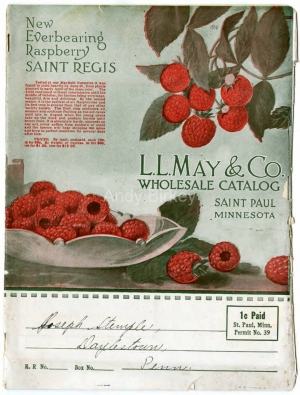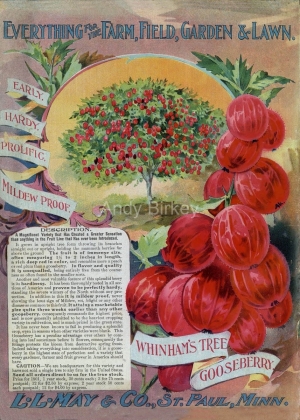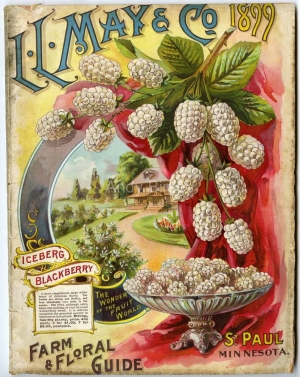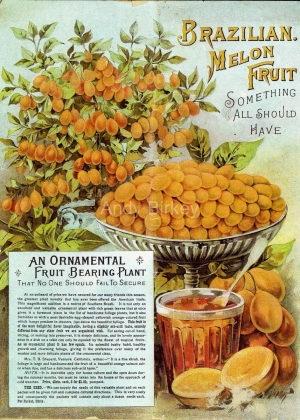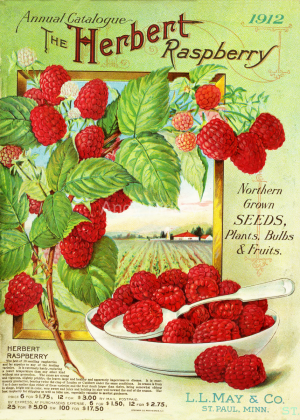Long before Adobe or Procreate or even MS Paint, there were good old fashioned pen, ink, paint, and brush illustration. Some of my favorite examples are from seed catalogues from the late-1800s and early 1900s. The copyright for these catalogues — and the beautiful illustrations within them — have expired and become part of the public domain. I’ve spent some time restoring these illustrations. One of my favorites is from a Minnesota company called L.L. May & Company that was in business in St. Paul from the 1880s to the 1920s.
L.L. May, situated at the corner of Como Avenue and Elfelt Street in St. Paul’s Frogtown neighborhood, was a nursery and seed grower with a large regional reach in the late 1800s and early 1900s. L.L. May & Co. grew wholesale and retail seeds, and provided florist and nursery services.
The internet doesn’t know much about L.L. May. According to an obituary, Lewis L May was born in Oshawa, Ontario, Canada in 1856. He moved to Winnipeg in 1974 to work at the Stone and Wellington Co. When its co-founder, George Stone died in 1882, May bought out the remaining partners and changed the name of the company to L.L May. He moved his family and company to St, Paul in 1881. His son, L. L. May, Jr., took over the business two years before his death. He was active in St. Paul civic life and served for one term as St. Paul Police Commissioner, and two terms on the school board. He died in 1917.
The mysterious Minnetonka Apple


In 1887, the horticulture gossip scene was filled with questions about L.L. May’s Minnetonka Apple. Was it a new cultivar or was it L.L. May passing someone else’s cultivar as his own?
Excerpt from The Minnesota Horticulturist, Volume 34:
What is the “Minnetonka” Apple? A recent letter from C. W. Gurney, of the Yankton, South Dakota, Nursery says “I see that some of the Minnesota nurserymen are advertising the Minnetonka apple. I have corresponded with some of them and find they heard of it through L.L. May & Co. and got the stock from trees of this variety or pretended variety that they have sent out. Some years ago I did the same thing and after a few years my Minnetonka turned out to be Longfield. If there is such an apple it should be taken up and discussed by your society, and if there is not it should be so stated in your reports. Prof. Hansen writes me that there is no apple of that name, and I feel sure he is right.” Is there such an apple?
The discussion continued and it got heated. The minutes of the Minnesota State Horticulturist Society show allegations that May was selling trees and misrepresenting where they were grown and what stock they were. His detractors said his company was lying when saying his apples were grown in Minnesota when they were actually grown in Rochester, NY. When a member said he called May’s headquarters and was told the apples he grew were from Minnesota, May said the member was lying.
May responded: “I will wager you a hundred dollars that no clerk in my office ever made that statement to you. I will put the money up and donate it to the orphan asylum. I tell you talk is cheap.”
Board member AW Latham said, “There is something wrong about his agents, and if he is responsible for them then he certainly will be in bad odor through the state of Minnesota.”
The Society stopped short of any official action against LL May, but just about every member of the board admonished him for his agents misrepresenting the items he sold.
Over the years, the company put out some interesting illustrations.
Brazilian Melon Fruit and Iceberg Blackberries
It took me a while to figure out what a Brazilian Melon Fruit is and why is is “something that all should have.” The best guess I could find was a loquat. Iceberg Blackberries appear to be a cultivar created by Luther Burbank. This white blackberry was developed in 1894.
Looking to get your own L.L. May & Co. print, postcard, or mug? Head over to my Redbubble shop!


